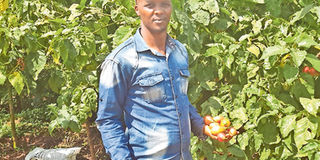Agronomist's notebook: Mite problem and how to overcome it

Tree tomato farmer, Michael Mwangi in his farm in Karatina. Mites often infest tomatoes, causing small wounds on the plant, which in turn act as entry points of micro organisms. PHOTO | JOSEPH KANYI | NMG
What you need to know:
- A tomato farmer may have observed curled, yellowed leaves that sometimes turn brown and fall off the plant, lowering production.
- They may not be visible to the naked eye so the farmer or crop expert needs to use a magnifying lens to identify them and their eggs.
- The mites are highly prolific especially during the dry and hot conditions as these favours their rapid development. The high multiplication rate helps them destroy the crop quickly.
- Farmers should also ensure their fields remain weed-free as some weeds are known to harbour and spread the red spider mites.
Every season comes with challenges to farmers. Fortunately, farmers can always find ways of overcoming many of these problems.
High temperatures usually lead to the rise in red spider mites’ numbers, especially in tomatoes, strawberries, beans, cucurbits capsicum, eggplants and several other crops.
A tomato farmer may have observed curled, yellowed leaves that sometimes turn brown and fall off the plant, lowering production.
On most occasions, the leaves curl upwards. The damage is usually severe in young plants as the flowers and fruits are affected.
It at times results in premature falling of fruit. Red spider mites are small. They are related to spiders and ticks. It should be taken into account that red spider mites are not insects. Young plants attacked by red spider mites are affected severely.
Their leaves curl, eventually resulting in stunted growth. Red spider mites are mostly found on the lower side of the leaf.
They may not be visible to the naked eye so the farmer or crop expert needs to use a magnifying lens to identify them and their eggs.
These mites live in colonies. They spin a silk-like thread that they use to anchor themselves and their eggs to the plant. A fine web protects them from their enemies and pesticides.
The mites are highly prolific especially during the dry and hot conditions as these favours their rapid development. The high multiplication rate helps them destroy the crop quickly.
To know if your field is infested with red spider mites, shake the plant over a white piece of paper. There are different species of red spider mites.
The mites also change colour, depending on their stage in life. This makes it difficult to control them.
They feed by piercing and sucking the plant cell sap, resulting in yellowing spots. This lowers the crop vigour.
Red spider mites can transit viral diseases.
The mites infest tomatoes, causing small wounds on the plant. The wounds act as entry points of micro organisms.
To control the red spider mites, farmers should observe their fields and plants regularly.
PREVENTION MEASURES PUT IN PLACE
Prevention measures should then put in place. These include proper spacing to control the movement of the pests.
Farmers should also ensure their fields remain weed-free as some weeds are known to harbour and spread the red spider mites.
One should also avoid planting next to infected crops since the pest spreads fast.
While carrying out management practices, one should be careful not to spread the pest by working on the non-infested areas first before moving to the infested areas.
In the case of capsicum and tomato plants, pruning should be done to allow free circulation of air in the field.
Since wind disperses the mites, the farmer should consider having windbreakers around the farm.
Infected plant materials should be destroyed by burning. Spraying pepper on the leaves can also control the pest.
Dust on leaves and fruits encourages red spider mite attack. Overhead irrigation helps control the mites by washing away the dust.
High-pressure water helps to remove the mites from the plants and destroy their webs.
Research has shown that African black nightshade helps to control the red spider mite since its leaves have a scent that attracts the pest.
Some leaves of the African black nightshade plant produce an odour that interferes with the reproduction of the pest.
The plant can thus be grown on the border of the field to trap the pest. Chemicals can also be used to control the red spider mite.
However, the farmer should ensure the chemical reaches underneath the leaves. Red spider mites and broad mites also affect capsicum, tomatoes, cucumbers and other crops.
They damage the meristematic plant tissues associated with the growing tip. This inhibits growth, decreases leaf number, leaf size, and area and plant height.
Proper field sanitation can control broad mites. One can also use a miticide with an active ingredient such as abamectin. When spraying, a broad coverage is encouraged.
While using biological control methods, it is critical to apply predatory mites such as Neoseulus californicus while the crop is still young.
Red spider and broad mites in plants should, however, not be confused with mites that affect livestock since these are blood suckers.





